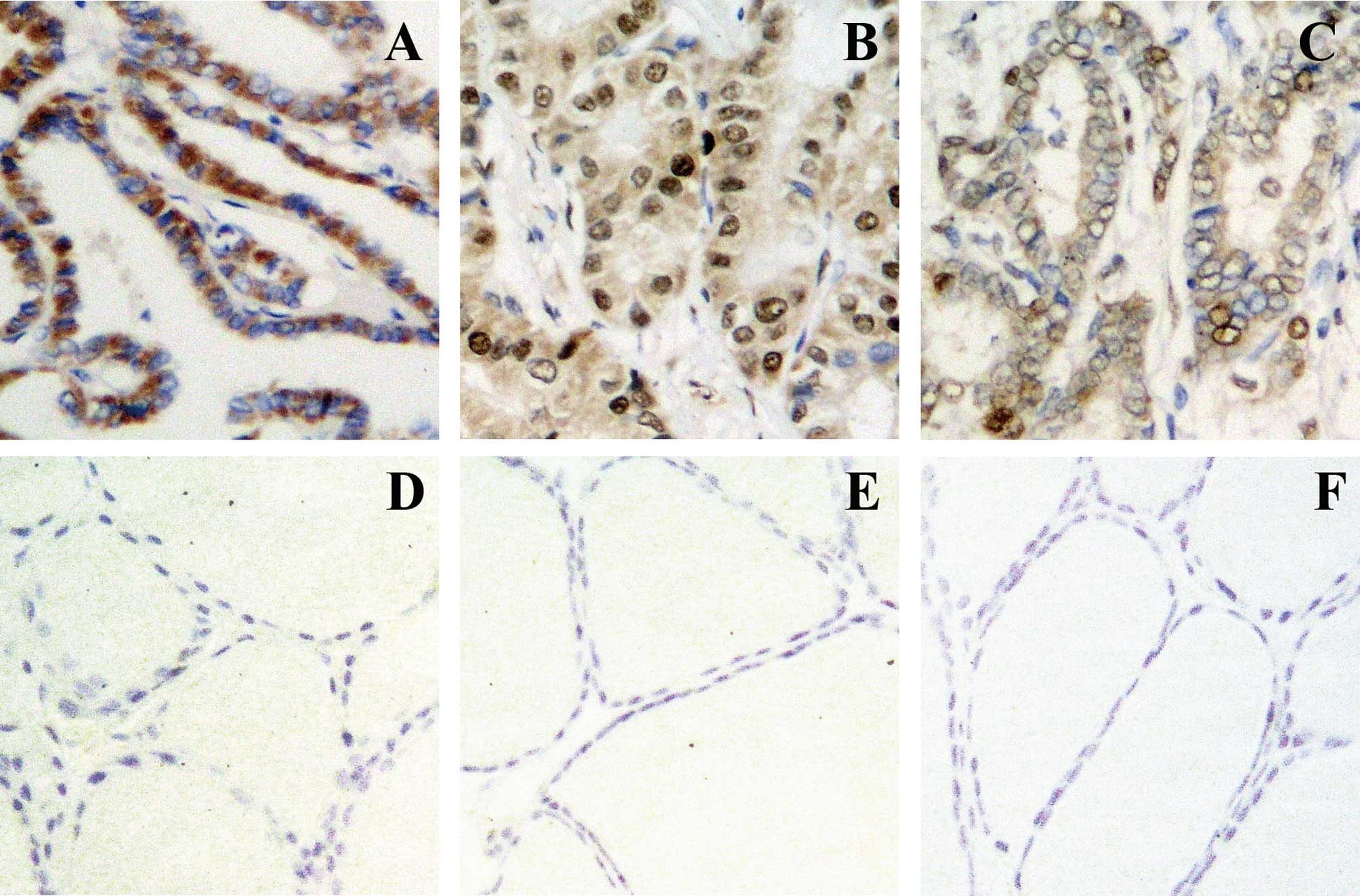|
1
|
Mai KT, Perkins DG, Yazdi HM, Commons AS,
Thomas J and Meban S: Infiltrating papillary thyroid carcinoma:
review of 134 cases of papillary carcinoma. Arch Pathol Lab Med.
122:166–171. 1998.PubMed/NCBI
|
|
2
|
Michaloglou C, Vredeveld LC, Mooi WJ and
Peeper DS: BRAF (E600) in benign and malignant human tumours.
Oncogene. 27:877–895. 2008. View Article : Google Scholar : PubMed/NCBI
|
|
3
|
Cohen Y, Xing M, Mambo E, Guo Z, Wu G,
Trink B, Beller U, Westra WH, Ladenson PW and Sidransky D: BRAF
mutation in papillary thyroid carcinoma. J Natl Cancer Inst.
95:625–627. 2003. View Article : Google Scholar : PubMed/NCBI
|
|
4
|
Dhomen N and Marais R: New insight into
BRAF mutations in cancer. Curr Opin Genet Dev. 17:31–39. 2007.
View Article : Google Scholar : PubMed/NCBI
|
|
5
|
Kebebew E, Weng J, Bauer J, Ranvier G,
Clark OH, Duh QY, Shibru D, Bastian B and Griffin A: The prevalence
and prognostic value of BRAF mutation in thyroid cancer. Ann Surg.
246:466–470. 2007. View Article : Google Scholar : PubMed/NCBI
|
|
6
|
Liu RT, Chen YJ, Chou FF, Li CL, Wu WL,
Tsai PC, Huang CC and Cheng JT: No correlation between BRAFV600E
mutation and clinicopathological features of papillary thyroid
carcinomas in Taiwan. Clin Endocrinol. 63:461–466. 2005. View Article : Google Scholar : PubMed/NCBI
|
|
7
|
Ito Y, Yoshida H, Maruo R, et al: BRAF
mutation in papillary thyroid carcinoma in a Japanese population:
its lack of correlation with high-risk clinicopathological features
and disease-free survival of patients. Endocr J. 56:89–97. 2009.
View Article : Google Scholar : PubMed/NCBI
|
|
8
|
Lassalle S, Hofman V, Ilie M, Butori C,
Bozec A, Santini J, Vielh P and Hofman P: Clinical impact of the
detection of BRAF mutations in thyroid pathology: potential
usefulness as diagnostic, prognostic and theragnostic applications.
Curr Med Chem. 17:1839–1850. 2010. View Article : Google Scholar : PubMed/NCBI
|
|
9
|
Kondo T, Nakazawa T, Murata S, Kurebayashi
J, Ezzat S, Asa SL and Katoh R: Enhanced B-Raf protein expression
is independent of V600E mutant status in thyroid carcinomas. Hum
Pathol. 38:1810–1818. 2007. View Article : Google Scholar : PubMed/NCBI
|
|
10
|
Baserga R: Growth regulation of the PCNA
gene. J Cell Sci. 98:433–436. 1991.
|
|
11
|
Leonardi E, Girlando S, Serio G, Mauri FA,
Perrone G, Scampini S, Dalla Palma P and Barbareschi M: PCNA and
Ki67 expression in breast carcinoma: correlations with clinical and
biological variables. J Clin Pathol. 45:416–419. 1992. View Article : Google Scholar : PubMed/NCBI
|
|
12
|
El-kott AF, El-baz MA and Mokhtar AA:
Proliferating cell nuclear antigen (PCNA) overexpression and
microvessel density predict survival in the urinary bladder
carcinoma. Int Urol Nephrol. 38:237–242. 2006. View Article : Google Scholar : PubMed/NCBI
|
|
13
|
Cvejic D, Selemetjev S, Savin S, Paunovic
I and Tatic S: Changes in the balance between proliferation and
apoptosis during the progression of malignancy in thyroid tumours.
Eur J Histochem. 53:65–71. 2009. View Article : Google Scholar : PubMed/NCBI
|
|
14
|
Jun SH, Kim TG and Ban C: DNA mismatch
repair system. Classical and fresh roles. FEBS J. 273:1609–1619.
2006. View Article : Google Scholar : PubMed/NCBI
|
|
15
|
Plevová P, Krepelová A, Papezová M, et al:
Immunohistochemical detection of the hMLH1 and hMSH2 proteins in
hereditary non-polyposis colon cancer and sporadic colon cancer.
Neoplasma. 51:275–284. 2004.PubMed/NCBI
|
|
16
|
Li M, Liu L, Wang Z, Wang L, Liu Z, Xu G
and Lu S: Overexpression of hMSH2 and hMLH1 protein in certain
gastric cancers and their surrounding mucosae. Oncol Rep.
19:401–406. 2008.PubMed/NCBI
|
|
17
|
Ciampi R, Zhu Z and Nikiforov YE: BRAF
copy number gains in thyroid tumors detected by fluorescence in
situ hybridization. Endocr Pathol. 16:99–105. 2005. View Article : Google Scholar : PubMed/NCBI
|
|
18
|
Wang L, Cunningham JM, Winters JL,
Guenther JC, French AJ, Boardman LA, Burgart LJ, McDonnell SK,
Schaid DJ and Thibodeau SN: BRAF mutations in colon cancer are not
likely attributable to defective DNA mismatch repair. Cancer Res.
63:5209–5212. 2003.PubMed/NCBI
|















